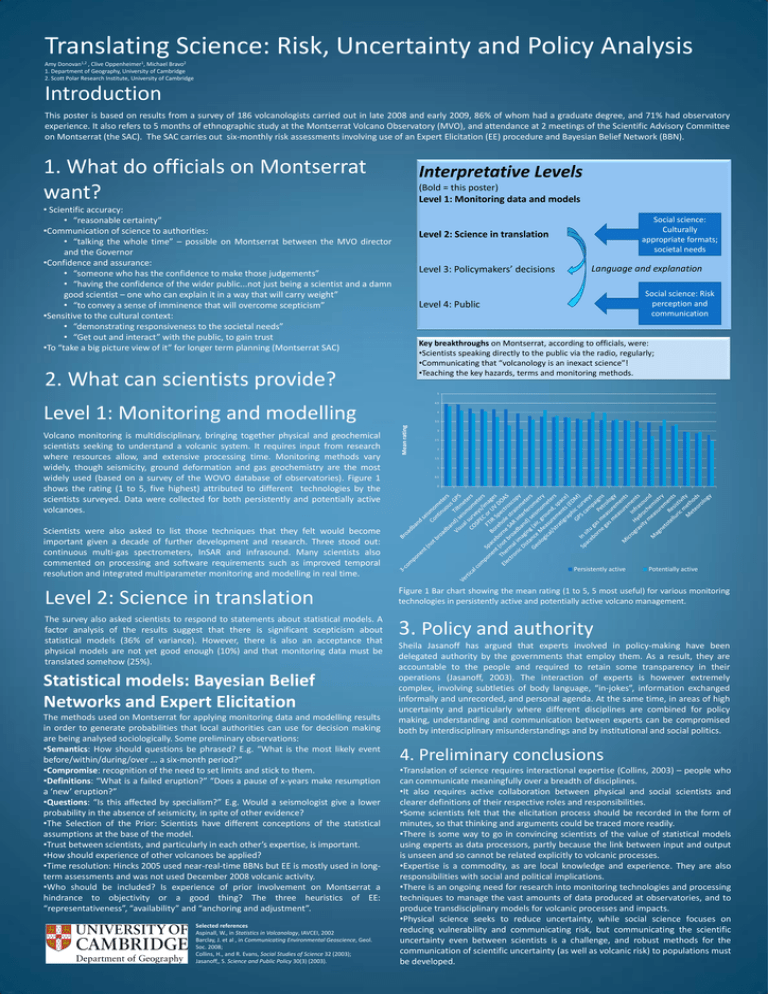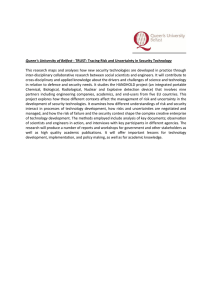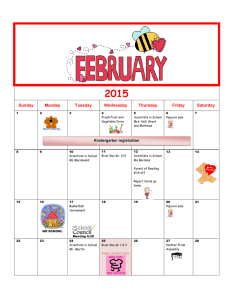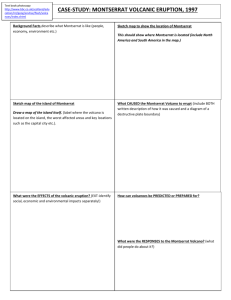Translating Science: Risk, Uncertainty and Policy Analysis Introduction
advertisement

Translating Science: Risk, Uncertainty and Policy Analysis Amy Donovan1,2 , Clive Oppenheimer1, Michael Bravo2 1. Department of Geography, University of Cambridge 2. Scott Polar Research Institute, University of Cambridge Introduction This poster is based on results from a survey of 186 volcanologists carried out in late 2008 and early 2009, 86% of whom had a graduate degree, and 71% had observatory experience. It also refers to 5 months of ethnographic study at the Montserrat Volcano Observatory (MVO), and attendance at 2 meetings of the Scientific Advisory Committee on Montserrat (the SAC). The SAC carries out six-monthly risk assessments involving use of an Expert Elicitation (EE) procedure and Bayesian Belief Network (BBN). 1. What do officials on Montserrat want? Interpretative Levels (Bold = this poster) Level 1: Monitoring data and models • Scientific accuracy: • “reasonable certainty” •Communication of science to authorities: • “talking the whole time” – possible on Montserrat between the MVO director and the Governor •Confidence and assurance: • “someone who has the confidence to make those judgements” • “having the confidence of the wider public...not just being a scientist and a damn good scientist – one who can explain it in a way that will carry weight” • “to convey a sense of imminence that will overcome scepticism” •Sensitive to the cultural context: • “demonstrating responsiveness to the societal needs” • “Get out and interact” with the public, to gain trust •To “take a big picture view of it” for longer term planning (Montserrat SAC) Social science: Culturally appropriate formats; societal needs Level 2: Science in translation Level 3: Policymakers’ decisions Language and explanation Social science: Risk perception and communication Level 4: Public Key breakthroughs on Montserrat, according to officials, were: •Scientists speaking directly to the public via the radio, regularly; •Communicating that “volcanology is an inexact science”! •Teaching the key hazards, terms and monitoring methods. 2. What can scientists provide? 5 4.5 Level 1: Monitoring and modelling Scientists were also asked to list those techniques that they felt would become important given a decade of further development and research. Three stood out: continuous multi-gas spectrometers, InSAR and infrasound. Many scientists also commented on processing and software requirements such as improved temporal resolution and integrated multiparameter monitoring and modelling in real time. 3.5 Mean rating Volcano monitoring is multidisciplinary, bringing together physical and geochemical scientists seeking to understand a volcanic system. It requires input from research where resources allow, and extensive processing time. Monitoring methods vary widely, though seismicity, ground deformation and gas geochemistry are the most widely used (based on a survey of the WOVO database of observatories). Figure 1 shows the rating (1 to 5, five highest) attributed to different technologies by the scientists surveyed. Data were collected for both persistently and potentially active volcanoes. 4 3 2.5 2 1.5 1 0.5 0 Persistently active Potentially active Level 2: Science in translation Figure 1 Bar chart showing the mean rating (1 to 5, 5 most useful) for various monitoring The survey also asked scientists to respond to statements about statistical models. A factor analysis of the results suggest that there is significant scepticism about statistical models (36% of variance). However, there is also an acceptance that physical models are not yet good enough (10%) and that monitoring data must be translated somehow (25%). 3. Policy and authority Statistical models: Bayesian Belief Networks and Expert Elicitation The methods used on Montserrat for applying monitoring data and modelling results in order to generate probabilities that local authorities can use for decision making are being analysed sociologically. Some preliminary observations: •Semantics: How should questions be phrased? E.g. “What is the most likely event before/within/during/over ... a six-month period?” •Compromise: recognition of the need to set limits and stick to them. •Definitions: “What is a failed eruption?” “Does a pause of x-years make resumption a ‘new’ eruption?” •Questions: “Is this affected by specialism?” E.g. Would a seismologist give a lower probability in the absence of seismicity, in spite of other evidence? •The Selection of the Prior: Scientists have different conceptions of the statistical assumptions at the base of the model. •Trust between scientists, and particularly in each other’s expertise, is important. •How should experience of other volcanoes be applied? •Time resolution: Hincks 2005 used near-real-time BBNs but EE is mostly used in longterm assessments and was not used December 2008 volcanic activity. •Who should be included? Is experience of prior involvement on Montserrat a hindrance to objectivity or a good thing? The three heuristics of EE: “representativeness”, “availability” and “anchoring and adjustment”. Selected references Aspinall, W., in Statistics in Volcanology, IAVCEI, 2002 Barclay, J. et al , in Communicating Environmental Geoscience, Geol. Soc. 2008; Collins, H., and R. Evans, Social Studies of Science 32 (2003); Jasanoff,, S. Science and Public Policy 30(3) (2003). technologies in persistently active and potentially active volcano management. Sheila Jasanoff has argued that experts involved in policy-making have been delegated authority by the governments that employ them. As a result, they are accountable to the people and required to retain some transparency in their operations (Jasanoff, 2003). The interaction of experts is however extremely complex, involving subtleties of body language, “in-jokes”, information exchanged informally and unrecorded, and personal agenda. At the same time, in areas of high uncertainty and particularly where different disciplines are combined for policy making, understanding and communication between experts can be compromised both by interdisciplinary misunderstandings and by institutional and social politics. 4. Preliminary conclusions •Translation of science requires interactional expertise (Collins, 2003) – people who can communicate meaningfully over a breadth of disciplines. •It also requires active collaboration between physical and social scientists and clearer definitions of their respective roles and responsibilities. •Some scientists felt that the elicitation process should be recorded in the form of minutes, so that thinking and arguments could be traced more readily. •There is some way to go in convincing scientists of the value of statistical models using experts as data processors, partly because the link between input and output is unseen and so cannot be related explicitly to volcanic processes. •Expertise is a commodity, as are local knowledge and experience. They are also responsibilities with social and political implications. •There is an ongoing need for research into monitoring technologies and processing techniques to manage the vast amounts of data produced at observatories, and to produce transdisciplinary models for volcanic processes and impacts. •Physical science seeks to reduce uncertainty, while social science focuses on reducing vulnerability and communicating risk, but communicating the scientific uncertainty even between scientists is a challenge, and robust methods for the communication of scientific uncertainty (as well as volcanic risk) to populations must be developed.





